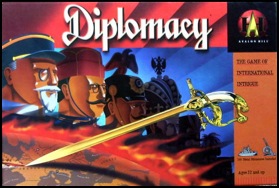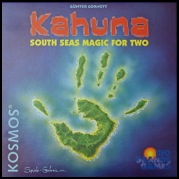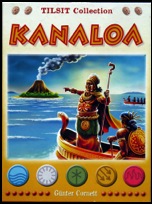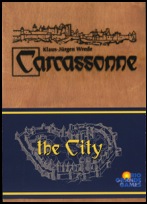Games with Nasty Intent
There are also games that have a bit of bait-and-switch to them. These games look innocuous but by playing them you quickly realize that they aren’t as nice as they appear. These are “wolf in sheep’s clothing” games, to continue the sheep theme, though I don’t know how much farther I can push it. Here I’m thinking of Tongiaki (Uberplay) and Kahuna (Rio Grande)/Kanaloa (Tilsit). Coincidentally, these games all have tropical themes, though I’m not sure if there’s anything in that.
These games use bright pretty colours, and you are lulled into a sense of serenity as if you were sitting on the beach having drinks with little umbrellas in them. That is, until you are rudely awakened from this illusion when your opponent cackles nastily and sinks your boats (Tongiaki) or blows your bridges off the island (Kahuna/Kanaloa), and does it with a smile. You soon realize that the bright pretty colours were hiding a game where you now have to fight for your life and the little umbrellas won’t save you.
I recently discovered that there is a third category of games that fit with this theme of nastiness (screwing up your opponent’s plans in a nasty fashion). These are games you have played for a while and know them to be “nice” games; known for their competition, surely, but not games that encourage nastiness. These games have well, I suppose you could say “chivalry” to them, or perhaps “gentlemanly competition”, where the competition is definitely present, but the gloves stay on. (I couldn’t think of how to fit sheep into this one, which is probably for the best.) Imagine a proper English tea on a sunny Sunday afternoon with a game of dominoes or backgammon. That kind of thing.
Well, I was rudely awakened recently when one of the games I had considered “chivalric” had suddenly revealed itself to have a nasty underbelly.
Carcassonne: The City by Rio Grande is a stand alone Carcassonne game. It doesn’t have any of the seemingly dozens of expansions from the base game. I believe it to be superior to the base Carcassonne game because of the walls; they close in the game, set a definitive time limit and add tension to the game. I have always though it to be chivalric.
Recently I’ve been regularly playing it with a group of friends over my lunch hour. Surely I can blame them, for they uncovered the nastiness in the game and took it to a level I never expected. I had nothing to do with this and was dragged along as an innocent. You do believe me, don’t you, Dear Reader? I am in earnest here!
Ahem.
At any rate, a recent game was so nasty that I took a couple of pictures of it. The first one below, you will notice the walls have almost entirely closed off the game. This occurs near the end of the game. Once the walls completely enclose the game, or you run out of tiles to place, the game is over.
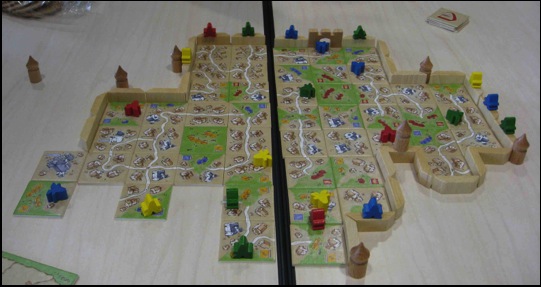
Players experienced with Carcassonne: The City will notice it very unusual that the number of tiles on the table is so small. In fact, a little less than half of them are left. The four players in this game have done a very good job of closing off many scoring avenues. This is usually done with walls.
But yet, there’s more nastiness to come. In the game the wooden playing pieces, called “meeples”, can be oriented in different ways. The ones lying down in the picture are called stewards, and gain you points at the end of the game for every green space that they are connected to. These connections only extend to a green space, a road, or the walls. So, you can stop an opponent from getting more points if you can enclose their steward in a smaller area. What are the smallest possible areas? Well, two of them manifested themselves in this game.
The first is in the picture below. This was such a nasty move that I took a picture of it as it was happening. Here the player (not me) is enclosing the blue steward entirely with green space, meaning blue will only get a pittance at the end of the game. This move was done, of course, with a smile.
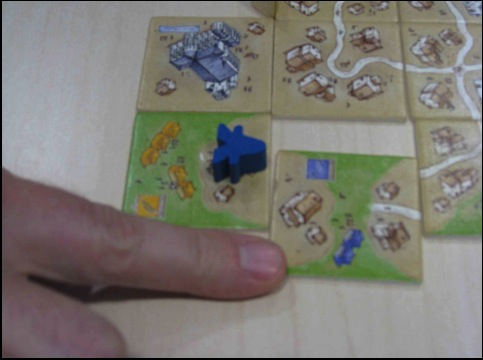
Later on one of my stewards was cut off from all green space using walls, earning me zero points!
All this goes to show that any chivalric game can be surprisingly drawn down into the muck with a combination of players with nasty intent. I had nothing to do with this and was dragged along as an innocent. You do believe me, don’t you, Dear Reader?
Playing with my Tablet
Based on a friend's recommendation, I also bought a copy of ArtRage. It is an amazing drawing tool that works wonderfully with the tablet, though you don’t need one to use the tool. I suppose I should really call it a "painting tool" because all of the digital materials behave very similar to their physical counterparts; brushes run out of paint or ink and streak, you can have oil paint textures, charcoal, pastels, smudges, and so on. Better than that, it's a great price!
Anyway, here's my first experiment with the tool. I was trying out the ink brush ideas for something similar to those Japanese brush paintings. The depths of abilities in these tools are wonderful and it will take me a while to get the hang of the techniques, but I think I'm going to have a lot of fun with them!




